-
Posts
1,287 -
Joined
-
Last visited
-
Days Won
32
Content Type
Profiles
Forums
Blogs
Gallery
Events
Store
Posts posted by oamotme
-
-
Gentlemen,
I recently obtained, in an assorted lot of British family medals - father and son, a Red Cross medal - unfortunately no documentation. Can any of you identify this for me? Is it a scarce piece and what is the period of issue?
Many thanks,
Owain
 0
0 -
Thanks for a most informative post - I had thought Rothe's had closed during or after WW2. All of our posts have been quite effective at closing off possible avenues of research - how frustrating. You remark that quality of workmanship can be used as an indicator of the period of production. The workmanship to me looks excellent and I would suggest pre-WW2. Similarly I believe the medal design also to be pre-WW2 and thus perhaps we can agree on the period of the award and move forward on this basis. James's image of a breast badge of the award with the crescent and star suspension to my mind further validates an Arabic source. The triangular ribbon if correct is a challenge, or is the green sash with red side stripes correct, or indeed the black, red, black ribbon of the medal?
Kind regards, Owain
0 -
James,
Thanks for your comments. Yes, it would be wise to look further afield but I suspect your candidates may not be the answer:
Ali Haidar, whilst the proclaimed Ottoman legitimate ruler of the Hijaz after the Arab Revolt to replace Hussain Bin Ali, was very much bound to the Ottoman authorities and once the Ottoman ruling house had been deposed lived in increasingly difficult circumstances - his autobiography makes no mention of any awards other than his own receipt of the Orders of the Medjide and Osmanie
Yemen - the only awards for the Kingdom were two designs and a prototype by Bichay of Cairo for Crown Prince Badr in late 1950's / early 1960's - with the1962 revolution these plans came to nothing and the new Yemen Arab Republic awards - again by Bichay, were instituted for the goverment of Sallal under the "encouragement" of Nasser - Orders of Sab'a, Marib and Medals of Bravery and Liberation. These in turn became obsolete with the overthrow of Sallal and the next series commenced in the early 1970's and manufactured by Skinner of Bond Street.
Lahej - all the awards I have seen were locally made and appear to be one off items - an unknown breast badge from the 1880's or 1890's, the Order of the Morning Star (breast badge), the Order of the Brilliant Sun (breast star) and two medals commemorating royal visits. In the 1990's I met in Jeddah Sultan Ali Abdul Karim Al Adbali, (deposed 1956) then in his early eighties and very lucid, who stated that as far as he was aware no awards had been instituted in his living memory.
Other South Arabian States with awards were the Qu'aiti Sultanate with Orders (medals) of Distiction and Merit dating from 1948 and whilst a review of the orders was conducted in 1966 the communist takeover halted this process. The Kathiri Sultan was considering an order based on the badge of the Schlaraffia Club of Sarajevo but again the communist takover and the exile of the Sultan meant that this also came to nothing.
Early Omani awards are limited to the Nobel Saeedee Order of Sultan Taimour 1913/14 and the 1932 Accession Medal of Sultan Said - the next series of awards commenced in the late 1950's with a service medal.
The use of the word "Arab" may reflect the increasing nationalism and identity of the Arab world from 1920 onwards and thus our search for other candiates contiunes. Do you know when Rothe ceased manufacturing awards?
Kind regards,
Owain
0 -
James and colleagues,
The mystery deepens - the incscription is quite clearly Arabic and formally written with all the lesser vowel signs included. If it is of pre-Great War manufacture then I still believe that it has some form of Egyptian connection but of course cannot prove this. In 1911/12 the Khedive instituted a Bravery Medal to complement the service medal instituted by Egypt. It may be that he was also considering the instituton of an Egyptian Order - the three Orders of the Egyptian monarchy were instituted by Sultan Hussein Kamel in 1915 - Mohammed Ali, Ismail and Nile. As Sultan he had also earlier instituted the Order of the Felaha (Peasant/Agricultural Worker). The style of the medal has though a decidedly Ottoman feel to it.
Regards,
Owain
0 -
Gentlemen,
Just a note but as far as the Kuwaitis are concerned this is the "Order of Liberation" and not just a Liberation medal. The words "Wissam At-tahrir" (Order of Liberation) are visible on the obverse of the 1st and 4th class grades, but not on the Excellent, 2hd or 3rd class grades.
With regard to the manufacture of the Order I have a letter from the Spink Medal Services Department dated 8 June 1998 where it is noted that ".......Spink did not in fact manufacture the Kuwait Liberation Medal (sic). We did supply Kuwait with the original designs along with a full quotation for manufacturing, but they then had the medals manufactured, very cheaply, somewhere in the Far East, we think Hong Kong." Spink did though, along with other manufacturers - Huguenin of Switzerland in Europe, manufacture the Saudi Liberation of Kuwait Medal. The box illustrated by Doc is a standard Spink issue box.
Kind regards from Riyadh,
Owain
0 -
Christer,
I agre with 922F's suggestions. I attach images of the possible medal. I met with Mr Bichay a couple of times in the early 1990's and he told me his father had been the manager or similar for Lattes and took over the business from Lattes in the 1930's. IO may be that the "takeover" was more of a "makeover".
Regards,
Owain
 0
0 -
Tim,
Your successor in Riyadh is just back from Addis and advises that there was quite a bit for sale but as he is not a collector so he did not buy anything and was also concerned about the ban on the export of militaria, etc. A German friend who has an Ethiopian frau notes that for some time there has been difficulty in bringing out any sort of collectible items but as a diplomat he has been able to side step such problems. Perhaps the key to success is to pack items in your hold luggage and not hand luggage. (On my most recent trip to Sana'a some 18months ago all bags were x-rayed and contents inspected.) For those who are interested in Ethiopian medals there is quite a bit for sale by the various dealers and auction houses in Europe. After the Derg was kicked out there was a rush of Ethiopian items onto the market. Items marked "Made by Sevadjian" may have come from a raided or disposed of stock in Addis. Don't forget that all of the Ethiopian orders and some of the medals have been manufactured in Europe - e.g. Mappin & Webb, Bertrand, and others. Items are also available our of Addis by variosu R-Bay vendors - the one I have used have been reliable.
Kind regards and to quote you, "Wales No 1 - I love you long time!"
Owain
0 -
Gentlemen,
The inscription on the Order of the Jihad is a quotation from the Koran and reads:
“And Allah prefers the Mujhadeen and bestows upon them great reward over those who remain behind.”
Regards,
Owain
0 -
Paul,
I'll try and get a translation of the Arabic on the medal - not sure if it is a religious or "Green Book" quotation.
Owain
0 -
Dragomir,
Many thanks. I suspect that the Ukranian Order is of a relatively recent institution. Whilst the Colonel's aspirations to African leadership are well known and hence his various African awards I was unware of any interaction between him and Ukraine. A quick seach notes a visit to Ukraine by the Colonel in November 2008 to discuss oil development - the order could have been awarded by President Yushchenko at this time. The photo of the two leaders has the Colonel with a selection of his personal female guards in a variety of uniforms - no medals or ribbons.
Regards,
Owain
 0
0 -
Great - many thanks for the prompt identification of these awards. Owain
0 -
...and the reverse,
Owain
 1
1 -
Dear All,
Until I obtained this I was unaware as to its existence. From the overall "greeness" of the design and ribbon I would assume it dates from the post 1979 period and the Colonel's Libyan Arab Socialist Peoples Jamahariya. At the bottom of the medal is the green map of the Arab world which echoes the design of the Order of the Great Conqueror. The medal weighs 53.5gms and is 62.3mm in diameter. The reverse bears the mark "STERLING SILVER - an award of British manufacture (?). The central design appears to be of eight hands facing inwards.
Regards,
Owain.
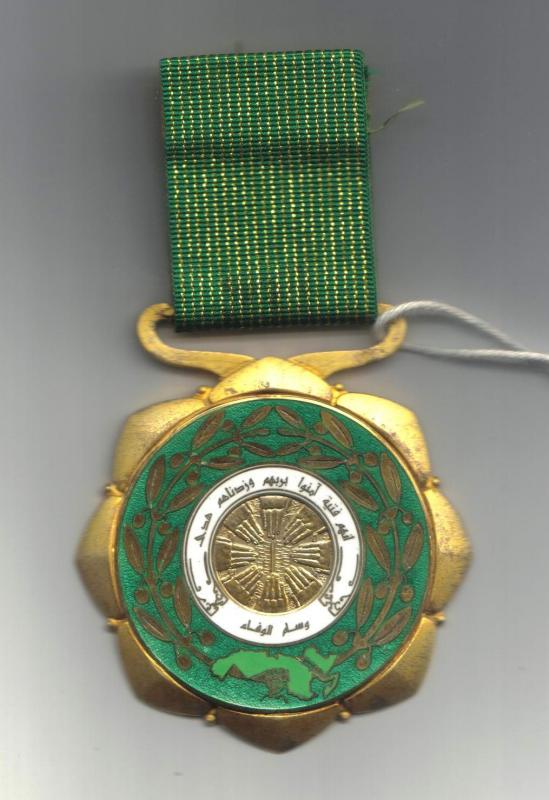 1
1 -
Dear All,
Illustrated below is an unoffical medallion of the Colonel, probably issued in the early years of the Libyan Arab Republic and manufactured in Egypt. Similar medals with bearing Nasser's head exist. The weight of the bronze (?) medalet is 19gms and it is 31.5mm diameter. The obverse reads " Al Aqeed Muamar Al Qadafi (Colonel...) and the reverse reads "Ya Rub" (Oh Lord) - a religious invocation.
Regards,
Owain,
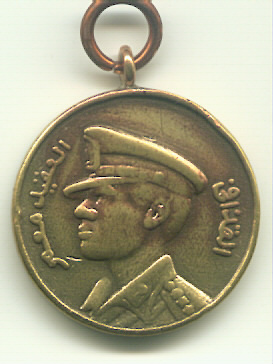
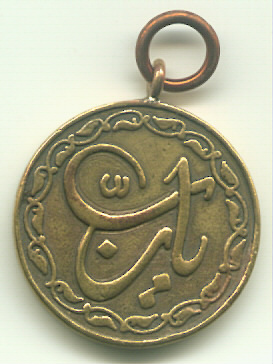 1
1 -
Dear All,
Another photo of Comrade Brother in a delightful powder blue number, wearing the full set. The sash from top to bottom:
- Order of Bravery - cannot see if this is a pin back star or a breast badge converted for wear in this fashion.
- Order of the Republic - the 1969-79 issue - unknown if a second "green" type exists.
- Order of the Great Conqueror - this could be a sash badge converted for wear on this sash as the full size breast star appears to be visible to the right.
- Order of the Jihad - usually a breast badge and this may have had its suspension removed.
- Order of Good Work - 2nd Type - the first type has red, white and black stripes in the centre.
- Order of the Good Citizen (to be confirmed) - usually a breast badge and this may have had its suspension removed.
To the right of the sash an assortment of Arab awards:
- Top - Egypt Star of Honour, Egypt Military Star; Unknown - not visible.
- 2nd - Libya Order of the Great Conqueror; Lebanon Order of Merit Exceptional Class; Oman Order of Oman (Military).
- 3rd - Not visible; Tunisia Order of 7th November; Not visible.
- 4th - Not visible.
To the left of the sash
- Top - Uganda - tbc.
- 2nd - Africa - tba ; Benin - tbc.
- 3rd - Aftrica - tba; Unknown; Mauritania Order of Merit .
No doubt Emmanuel will be able to clearly identifiy these African awards.
Regards,
Owain
 0
0 - Order of Bravery - cannot see if this is a pin back star or a breast badge converted for wear in this fashion.
-
...and an image of the reverse of these medals.
Owain.
 1
1 -
Dear All,
I attach images of these awards:
The Decoration of Training is from the Libyan Arab Republic period of 1969-79, weighing 28.4gms and 37.6mm in diameter. The reverse bears an 800 silver mark. I am unsure if the ribbon is correct.
The Decoration of War Wounded is also from the Libyan Arab Republic period of 1969-79, weighing 30.7gms and 37.4mm in diameter. The reverse bears an 800 silver mark. I do not know what colour the ribbon should be.
Regards,
Owain
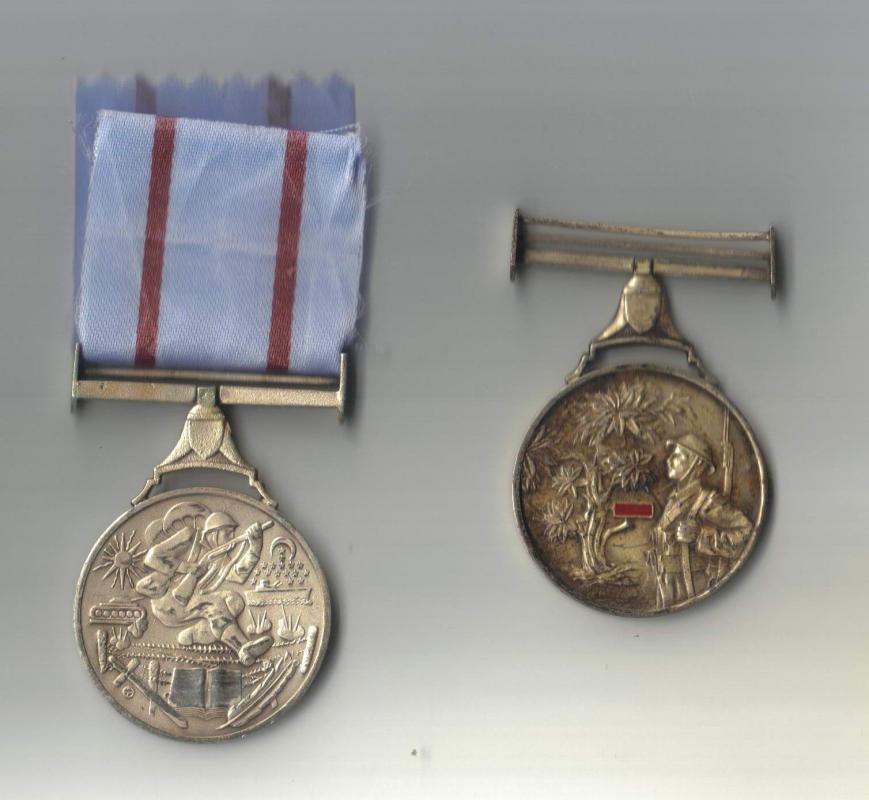 1
1 -
..and the reverse,
Owain
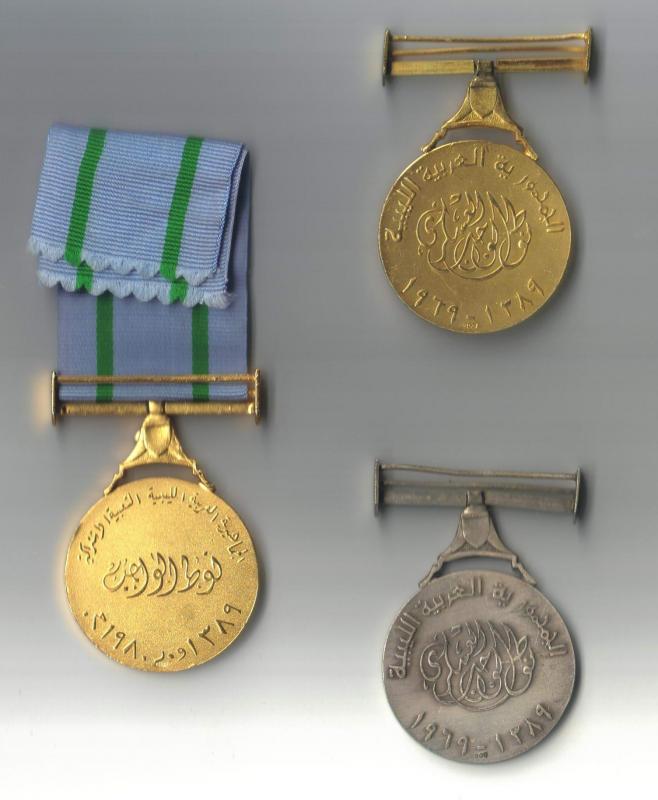 1
1 -
Paul,
No idea where you could get ribbons - possibly BOMISA in Milan? I attach images of the medals in my collection - the ribbon is blue with green stripes not red stripes. As well as two classes of the medal there are two types - the Libyan Arab Republic 1969-79 and the Libyan Arab Peoples Socialist Jamahuryia 1979-2011. The 1st type weighs 27.4gms and is 37.5mm in diameter. The 2nd type, with ribbon, weighs 29.3gms and is 37.6mm in diameter. The reverse bears an 800 silver mark - again probably of Italian manufacture.
Owain
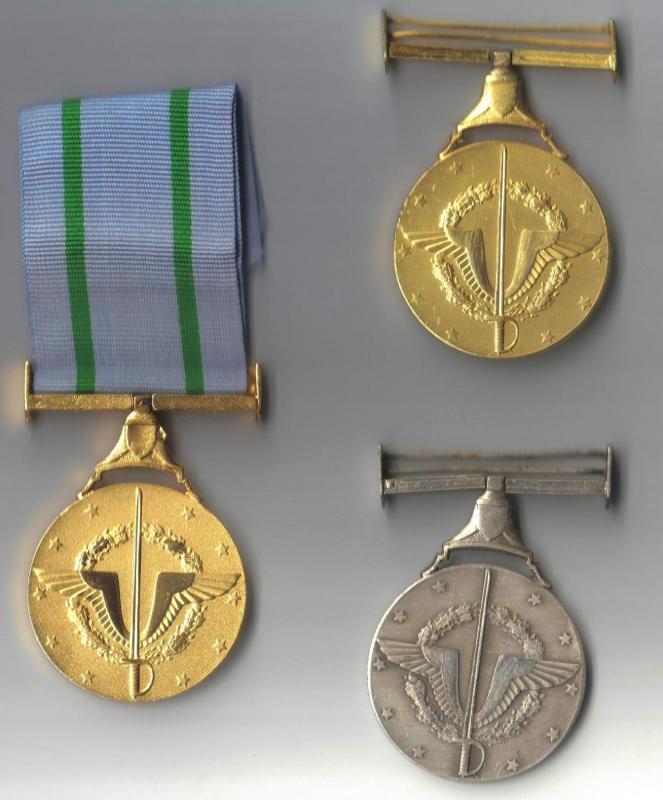 1
1 -
...and another, silver or second class. Ribbon seems authentic and it may well be that this class has a plain green ribbon but I cannot be sure.
Owain
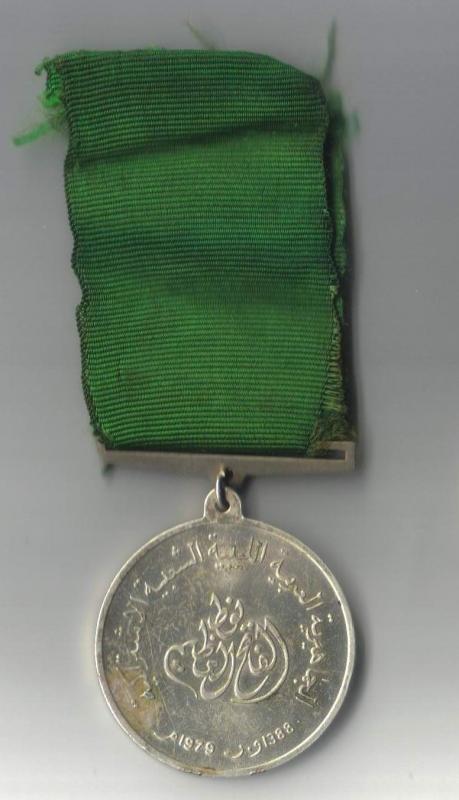
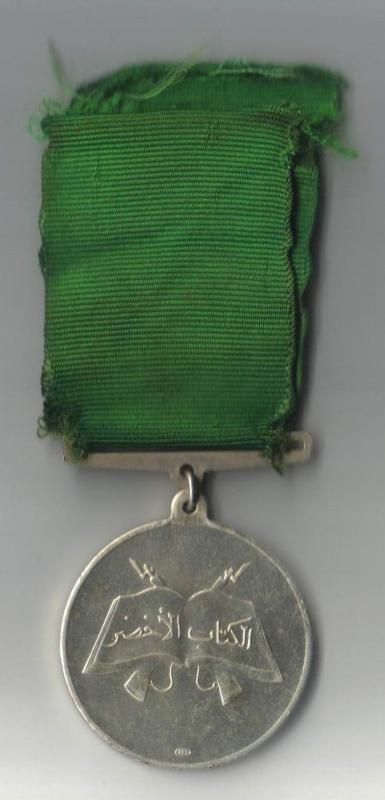 1
1 -
...and another gilt example, worn but with original ribbon and brooch.
Owain
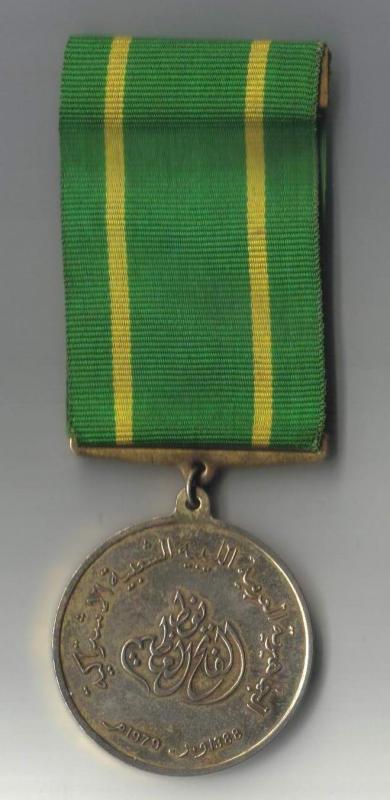
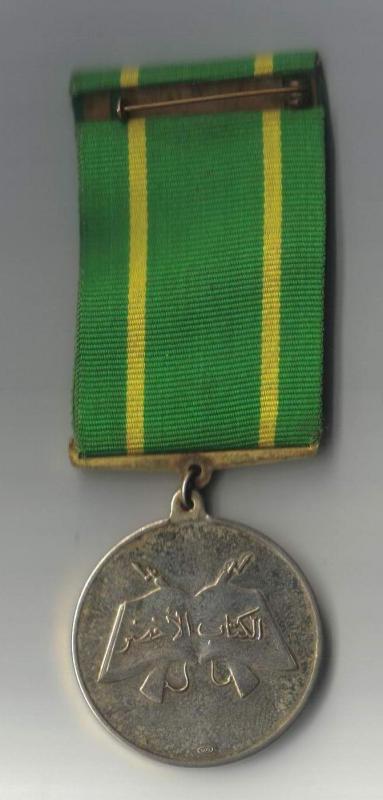 1
1 -
Dear Megan & Gentlemen,
Another delight from the Colonel's regime after he went "green" and this award comes from after 1979 when the Great Libyan Arab Peoples Jamahyria was declared. It comes in at least two classes - gilt and silver, and weighs in at some 27gms without suspension and is 37.6mm in diameter. From the examples illustrated the correct ribbon is the green with two yellow stripes. Each reverse in addition to depicting the infamous "Al Kitab Al Akhdar" - The Green Book, also bears an 800 silver mark. Manufacture is probably Italian.
Regards,
Owain
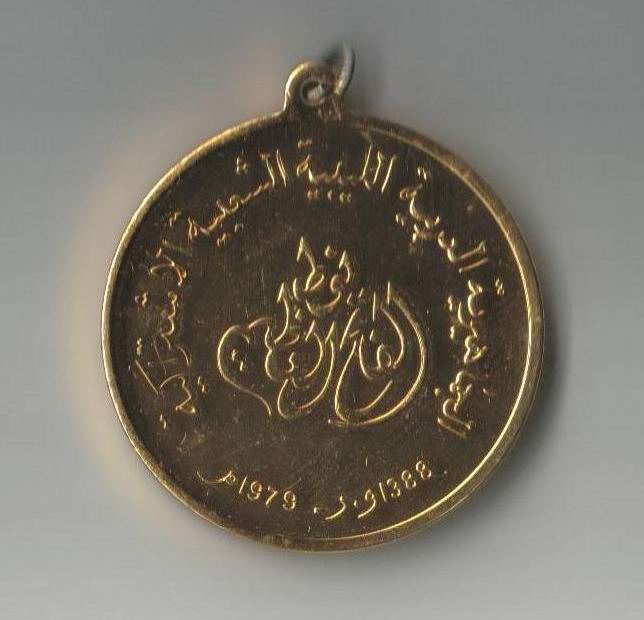
 1
1 -
With regard to the Order of Bravery I attach a picture of the brave Colonel wearing the medal from a red ribbon.
Owain
 0
0 -
And finally the Order of the Jihad - from the same period - the early years of the Libyan Arab Republic - see colour scheme on reverse. Weighing in at a massive 132.2gms and 80.1mm in diameter. Of one piece construction and the upper right of the reverse suspension bears the makers mark "BOMISA" and an 800 silver mark. Ribbon unknown but possibly green.
Owain

 1
1



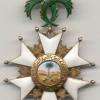
Unknown Chinese (Taiwan?) Red Cross Medal
in China
Posted
....and the reverse.
Owain